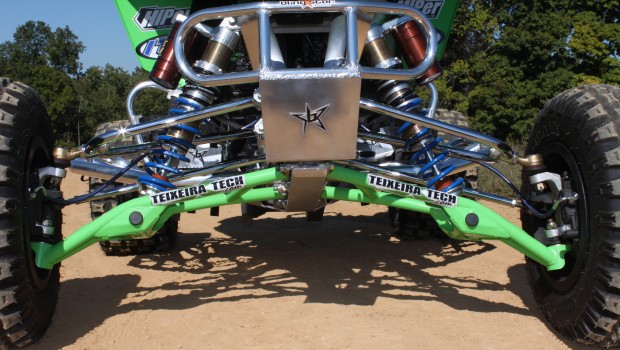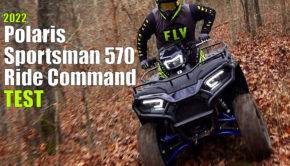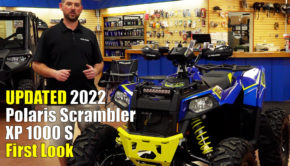Teixeira Tech Maximum Ground Clearance MX A-Arm Test.
Quality, options, and lightning-fast adjustment make Teixeira Tech stand out in a sea of copycat a-arms.

If you ride a fast track one week, then a small, tight track the next, changing your caster settings to suit the track can impact lap times.
Most of today’s stock high-performance ATVs have a lot of adjustments built into them to help you fine tune the machine. There are the controls, fully adjustable shocks, chain adjustment, tire pressure, and possibly more. Add in a high-end steering stabilizer like a Precision Pro Model, and you have another couple knobs to tune. Some stock, and most aftermarket, axles feature adjustable length. Now, install a set of aftermarket a-arms and you add camber and caster adjustment to go along with adjustable toe-in. By the time your ATV is race-ready, you could easily have over two dozen points of adjustment on the chassis and suspension alone. On top of that, the optimal setting for many of these adjustments can change from track to track. That’s a lot of tuning for a racer to deal with.
There are a few main reasons people buy aftermarket a-arms: to widen their machine, to allow for the use of long travel aftermarket shocks, and to add camber and caster adjustment. Camber refers to the amount the tops of your wheels tilt in. Toe-in, adjustable on any stock ATV, measures the amount the front of your wheels angle in or out. Once dialed in, you rarely need to mess with them. Caster refers to how far back the upper ball joint is in relationship to the lower ball joint. Move the upper ball joint back to add caster and gain high speed stability; or move the upper ball joint forward, closer to the lower ball joint, to reduce caster and speed up steering. If you ride a fast track one week, then a small, tight track the next, changing your caster settings to suit the track can impact lap times.
The easier it is to adjust something, the more likely most racers will be to take advantage of it. That’s the number one reason why we choose Teixeira Tech’s a-arms for our KFX450R Motocross Project, and why you may want to check them out for yourself.
Technical Stuff
Company owner, Ed Teixeira, is an experienced motocross and desert racer, so he understands the importance of keeping parts light without sacrificing durability. The tig-welded arms are constructed of 4130 chromoly. They make the KFX +2.125in. wider per side and move the front wheels forward ½ in. Moving the front wheels forward extends the wheelbase for better, high-speed stability; it transfers weight to the rear tires for improved traction, and reduces the rear end’s leverage over the front end, helping keep the machine more level under acceleration and flying jumps. The Teixeira arms allow for the use of long travel shocks and more suspension travel–– two things the KFX needs to compete on the track.

Teixeira’s easy-to-use Caster adjustment system lets you choose between 3 and 8 degrees of caster in 1.125-degree increments.
Teixeira’s easy-to-use Caster adjustment system lets you choose between 3 and 8 degrees of caster in 1.125-degree increments. Their notched upper a-arm, castle washer design allows you to make caster change in less than three minutes. The process is virtually fool proof with no need to measure. This gives you an edge over your competition by allowing you to easily and quickly dial in your steering to best suit the track. Most other systems require you to carefully and correctly measure the front end on a flat surface in order to prevent misalignment, which is why many amateur racers rarely mess with it and often wind up with front ends that aren’t dialed in properly.
Teixeira Tech uses Italian-made, sealed Frap ball joints, which they claim are the finest available. The a-arms are available with a needle bearing upgrade to the standard Delrin bushings. According to Teixeira, the needle bearing upgrade reduces maintenance and saves money over time on replacement part costs, so we opted for the upgrade. Zerk fittings come standard, allowing you to easily grease front-end pivot points.
Wrinkle Black powder coat is the standard finish, but Teixeira offers a number of custom color and chroming options.
The Test
Ed Teixeira tells us that he believes the Kawasaki’s KFX450R has the best handling front-end geometry in the class with his a-arms installed and dialed in–– we understand why he feels that way! With 4.125 degrees of caster dialed in on our Teixeira arms, coupled with long travel Race Tech shocks that don’t pack under hard braking, the nervous tendency of the KFX’ stock front end is gone. You can charge corners harder, braking later thanks to the machine’s increased stability and steering predictability. Although high-speed stability was much improved, there was no trade off when it came to steering. This KFX can still cut an inside line with the best of them.

You can charge corners harder, braking later thanks to the machine’s increased stability and steering predictability.
For sandy or muddy tracks that develop deep ruts, the reverse gull wing design of the MGC arms will help keep them from dragging the ground. We did manage to drag them through a few berms, which left the arms unblemished thanks to the tough powder coat finish.
Conclusion
It’s too bad that Teixeira Tech doesn’t have a big name pro racer like Chad Wienen or John Natalie for all the posers to latch onto. Honestly, though, it’s not the big name racer with a full-time mechanic who will benefit most from Teixeira’s unique a-arm design. It’s the average racer, who sets up their own machine and pays for the parts, that will benefit the most from a set of Teixeira Tech a-arms.
Manufacturer: Teixeira Tech
Product: MGC A-arms
Base Price: Most models $985 KFX450R $1,085
As Tested: $1,345
Teixeira Tech, MGC Motocross A-Arms, Test
Summary: It’s too bad that Teixeira Tech doesn’t have a big name pro racer like Chad Wienen or John Natalie for all the posers to latch onto. Honestly, though, it’s not the big name racer with a full-time mechanic who will benefit most from Teixeira’s unique a-arm design. It’s the average racer, who sets up their own machine and pays for the parts, that will benefit the most from a set of Teixeira Tech a-arms.












